Education and Training: A report on authorisation and monitoring activity for the period 1 September 2013 to 31 August 2014
22 May 2015
Introduction
- 1.
The responsibility for developing the framework for the education and training of solicitors sits within the SRA's regulatory policy unit. Alongside this function we also undertake the authorisation and routine monitoring of education and training providers.
- 2.
The purpose of this report is to tell our stakeholders about the outcomes of our quality assurance activity in relation to education and training. It captures authorisation of training providers, including firms and higher education providers. Unless otherwise stated, it covers the period 1 September 2013 to 31 August 2014. This reflects the higher education academic year.
Overview of the year
- 3.
This year our work on solicitor education and qualifications has largely taken place on two fronts: removing unnecessary regulation and processes from the existing framework and looking forward to a new approach to assuring standards of solicitor competence. In October 2013 we published our policy statement, Training for Tomorrow, in which we set out our proposals for reform of the current qualification framework to achieve a sharper focus on securing standards.
The current qualification framework
- 4.
Alongside our work on Training for Tomorrow, we undertook a review of the regulatory framework in which the current qualification pathways operate. We took account of changes in employment law and the regulation of higher education and the outcome of this work has been to simplify and reduce the cost of regulation by:
- removing the need for students to enrol with us before commencing the Legal Practice Course (LPC)
- permitting university providers of the qualifying law degree (QLD) and Common Professional Examination (CPE) to self-declare compliance with academic stage requirements
- retaining the requirements for training but removing the need for it to be undertaken according to the terms of a formal training contract specified by us
- removing the minimum salary for trainees and replacing it with the requirement to comply with the Minimum Wages Act
- reducing the LPC student registration fee from £120 to £15
- removing restrictions relating to the number of practising certificates a training principal must have and the number of trainees that firms and organisations may appoint
- introducing greater flexibility into the route to qualification by recognising that required outcomes may be met by 'Equivalent Means'.
The route to qualification
- 5.
Figure 1 sets out the routes to qualification as a solicitor. The graduate route will take a minimum of 6 years for those who study full time and undertake a recognised period of training (PRT) of 2 years (when undertaken full time). Figure 1 also illustrates the routes available to legal executives and lawyers qualified in other jurisdictions.
Figure 1
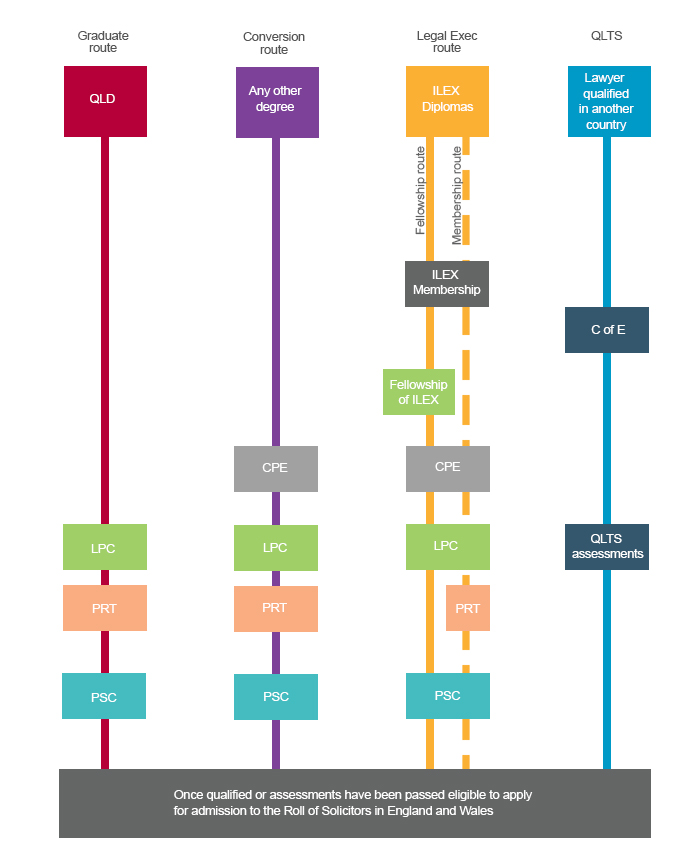
- 6.
Figure 2 identifies the routes to qualification taken by those who were admitted as solicitors between 1 September 2013 and 31 August 2014. In this period, 6,547 solicitors were admitted to the roll of which 47% had followed the QLD pathway and 30% had completed the CPE. The Qualified Lawyer Transfer Test (QLTT) and Qualified Lawyers Transfer Scheme (QLTS) represent barristers of England and Wales and lawyers qualified in other jurisdictions and account for just over 16% of those admitted to the roll in the same period. The QLTT ceased to be available as a route to the profession from 31 August 2010. It was replaced by the QLTS which is a two stage assessment of the knowledge and skills outcomes required to be a solicitor. The number of entrants to the profession via the QLTT route reflects those individuals who were entitled to continue on the QLTT by way of transitional arrangements.
Figure 2
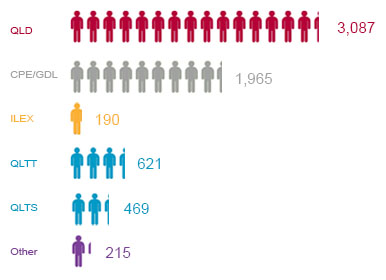
The providers of legal education and training
- 7.
Figure 3 sets out the numbers of organisations authorised by us to provide legal education and training. They range from universities which offer only the QLD, to those whose portfolio of provision includes a full range of pre and post qualification courses. All pre-qualification education takes place in providers which are also subject to regulation by the Quality Assurance Agency for Higher Education (QAA); the training period takes place in firms and organisations authorised by us to provide training. There are 40 providers of the CPE and 26 providers of the LPC. Two providers offer their courses across a number of locations; six providers offer a programme which combines the QLD and the LPC (the exempting degree). Seven providers are authorised to offer Higher Rights of Audience assessment (HRA) and three offer assessment to providers of police station advice and representation (PSRAS).
Figure 3
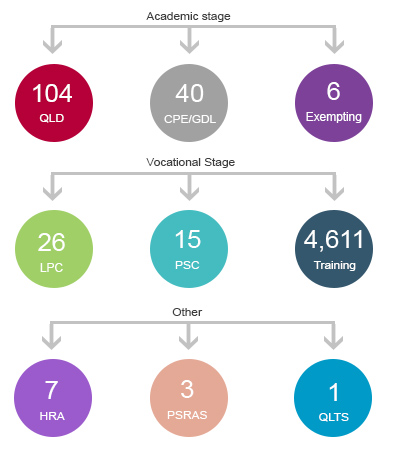
- 8.
In 2013/14, 752 additional firms and organisations were authorised by us to take trainees. This took the total number of firms and organisations authorised to take trainees to 4611 which represents almost 44% of all organisations approved and regulated by us to provide legal services. In the same period we revalidated a small number of QLD, CPE and LPC providers. See Figure 4.
Figure 4
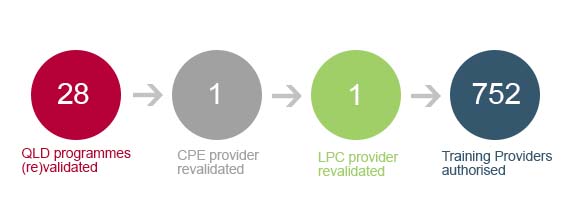
SRA monitoring
- 9.
SRA monitoring of the quality and standards of education and training focuses on the 2 professional qualifications within the framework: the Common Professional Exam (CPE) and the Legal Practice Course (LPC). For the CPE this involves initial validation and the requirement for each provider to submit an annual course monitoring report; for the LPC it also includes for this period external oversight by SRA appointed external examiners. The data includes in Figures 5, 6, 7, 8 and 10 is drawn from provider annual course monitoring reports.
The Legal Practice Course
Completion rates
- 10.
Figures 5 and 6 set out details of LPC completion rates. The total number of students who were enrolled and eligible to sit assessments which would enable them to complete the LPC in the period of the report was 8,372. This includes full time students enrolling for the first time in September 2013 (or later if studying on a fast-track programme); part time students in their second year of study and students who enrolled in earlier years but had outstanding assessment attempts available from previous years (i.e. they were students whose assessments had been deferred or referred from an earlier period). LPC assessment rules permit 3 attempts at each assessment.
Figure 5
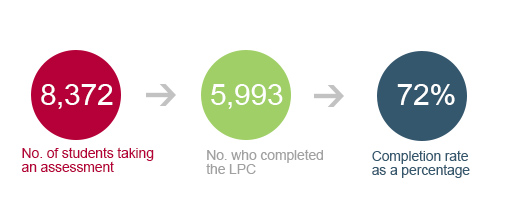
- 11.
The size of LPC provision varies: the largest providers BPP University and the University of Law offer the LPC across a number of different locations and between them shared 72% (6,012) of the total number of students enrolled to take assessments. 11 providers had less than 50 students. The largest traditional university providers were De Montfort University, Nottingham Trent University and University of the West of England. Huddersfield University had the smallest cohort. 62% of those taking assessments in this period were female. The data collected from LPC providers shows a diverse cohort of students.
- 12.
The average completion rate was 70% (It was 78% in 2011/12 and 75% in 2012/13). Those who did not complete include those who withdrew, failed the course or were deferred or referred in assessment. 16 providers had completion rates above the average and 4 providers had a completion rate below 50%. The highest completion rate was 96% and the lowest 39%. Figure 6 provides a breakdown of completion rates by gender, ethnicity, age and disability. The completion rates between male and female students is consistent but as between students from different ethnic groups, black students perform less well on the LPC. Asian/Asian British students accounted for 20% of the students attempting assessments and within that group had a completion rate of 59%. Students of Black/African/Caribbean/Black British ethnicity accounted for 6% of students but within this group the completion rate was 49%. White students accounted for 59% of the cohort and achieved a completion rate of 80%. 9% of students disclosed they had a disability and within this group, there was a completion rate of 64%.
Figure 6
| Gender | Number enrolled | Number completed | As a percentage |
|---|---|---|---|
| Male | 3,113 (37%) | 2,237 | 72% |
| Female | 5,256 (63%) | 3,756 | 71% |
| Not stated | 3 | - | - |
| Total | 8,372 | 5,993 | - |
| Ethnicity | Number enrolled | Number completed | As a percentage |
|---|---|---|---|
| Asian/Asian British | 1,649 (20%) | 972 | 59% |
| Black/African/Caribbean/Black British | 538 (6%) | 266 | 49% |
| Mixed/Multiple Ethnic Group | 265 (3%) | 188 | 71% |
| Other Ethnic Group | 197 (2%) | 125 | 63% |
| Prefer not to say | 272 (3%) | 155 | 57% |
| White | 4,904 (59%) | 3,939 | 80% |
| Not stated | 547 (7%) | 348 | 64% |
| Total | 8,372 | 5,993 | - |
| Disability | Number enrolled | Number completed | As a percentage |
|---|---|---|---|
| Yes | 768 (9%) | 490 | 64% |
| No | 5,603 (67%) | 4,047 | 72% |
| Prefer Not to say | 37 (1%) | 7 | 19% |
| Unknown | 1,964 (23%) | 1,449 | 74% |
| Total | 8,372 | 5,993 | - |
External examiner reports
- 13.
All external examiners for the LPC report that the quality and standards set by the SRA are maintained. They report high levels of student satisfaction with the quality of learning and teaching. Some external examiners expressed concern about the lack of rigour in assessment and a lack of internal scrutiny to ensure assessments were clear and free from error. External examiners reported that where this occurred, providers were responsive to external examiner recommendations and feedback.
Positive qualities
- links with practitioners and use of guest speakers
- clear and embedded professional context
- legal clinic
- quality of pastoral care
- quality of teaching
- agreed codes of conduct to define expectations amongst students and staff particularly in relation
- to group working
Areas of concern
- lack of rigour in assessment
- generous marking
- insufficient scrutiny of assessment to remove errors
- failure to maintain levels of staffing when members of staff leave
The Common Professional Examination/Graduate Diploma in Law
Completion rates
- 14.
Figures 7 and 8 set out details of CPE completion rates. The total number of students who were enrolled and eligible to sit assessments which would enable them to complete the CPE in the period of the report was 4,455*. This includes full time students enrolling for the first time in September 2013 (or later); part time year students in their second year of study and students who had referred or deferred assessment attempts because they had previous unsuccessful assessment attempts or for extenuating circumstances were unable to complete an assessment. CPE assessment rules permit 3 attempts at each assessment.
Figure 7
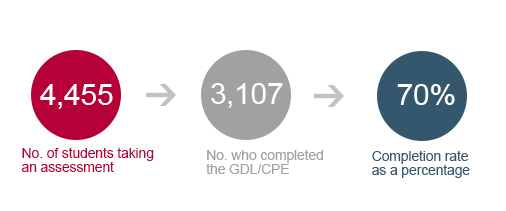
- 15.
As with the LPC, the size of CPE provision varies and is offered by a range of providers all of which are currently also subject to regulation by QAA. The largest providers, BPP University and the University of Law, offer the CPE across a range of locations and between them shared 75% (3,339) of the total number of students enrolled to take assessments. 21 providers had less than 50 students. The largest traditional university providers were De Montfort University, Nottingham Trent University, City University and Manchester Metropolitan University. Lincoln University and Leeds Beckett University had the smallest cohorts.
- 16.
The average completion rate was 72%. As with the LPC, 16 providers had completion rates above the average and 4 providers had a completion rate below 50%. The highest completion rate was 98% and the lowest 35%. Figure 8 provides a breakdown of completion rates by gender, ethnicity, age and disability. The completion rates between male and female students is consistent. Asian/Asian British students accounted for 13% of the students attempting assessments and within that group had a completion rate of 60%. Students of Black/African/Caribbean/Black British ethnicity accounted for only 5% of students and within this group the completion rate was 47%. White students accounted for 61% of the cohort and achieved a completion rate of 81%. 9% of students disclosed they had a disability and within this group there was a completion rate of 68%.
Figure 8
| Gender | Number enrolled | Number completed | As a percentage |
|---|---|---|---|
| Male | 1956 (44%) | 1352 | 69% |
| Female | 2494 (56%) | 1755 | 70% |
| Not stated | 5 | - | - |
| Total | 4455 | 3107 | - |
| Ethnicity | Number enrolled | Number completed | As a percentage |
|---|---|---|---|
| Asian/Asian British | 563 (13%) | 315 | 60% |
| Black/African/Caribbean/Black British | 204 (5%) | 95 | 47% |
| Mixed/Multiple Ethnic Group | 161 (4%) | 115 | 71% |
| Other Ethnic Group | 107 (2%) | 61 | 57% |
| Prefer not to say | 189 (4%) | 99 | 52% |
| White | 2705 (61%) | 2191 | 81% |
| Not stated | 526 (12%) | 231 | 44% |
| Total | 4455 | 3107 | - |
| Disability | Number enrolled | Number completed | As a percentage |
|---|---|---|---|
| Yes | 422 (9%) | 286 | 68% |
| No | 1245 (30%) | 892 | 72% |
| Prefer Not to say | 1395 (31%) | 1083 | 78% |
| Unknown | 1393 (31%) | 846 | 61% |
| Total | 4455 | 3107 | - |
* The statistics in figures 7 and 8 do not include the 62 students for 1 provider who did not submit details in time to be included in this report
Training
- 17.
The final stage of the qualification pathway is the requirement to complete a period of training (and during which time trainees will undertake the Professional Skills Course). Training will take place in a firm or organisation approved by us to take trainees and if undertaken on a full time basis will usually be for a period of 2 years. The tables in figure 9 provide details of the training contracts registered with us in the periods 1 July 2012 to 30 June 2013 and 1 July 2013 and 30 June 2014. Whilst our data is accurate to indicate that firms and organisations are recruiting more female than male trainees, we have an incomplete picture of the ethnicity of trainees: a high percentage of trainees registering with us did not disclose their ethnicity. This is a gap in our understanding of our trainee solicitor population and the progression of students from university into work place learning. The number of LPC graduates who had disclosed a disability and who secured a training contract in these periods is less than 1 percent. Figure 6 shows that in 2013/14 9% of LPC graduates had disclosed a disability and although the trainees captured in the numbers in figure 9 will unlikely to be from the cohorts captured in figure 6, the numbers do indicate that students with disabilities may be less successful in obtaining training contracts than those who do not have a disability, or that they chose not to disclose their disability.
Figure 9
| Gender | 1 July 2012 to 30 June 2013 | 1 July 2013 to 30 June 2014 | ||
|---|---|---|---|---|
| Female | 3,413 | 62% | 3,362 | 61% |
| Male | 2,104 | 38% | 2,165 | 39% |
| Total | 5,517 | - | 5,527 | |
| Ethnicity | 1 July 2012 to 30 June 2013 | 1 July 2013 to 30 June 2014 | ||
|---|---|---|---|---|
| Asian | 546 | 10% | 429 | 8% |
| Black | 111 | 2% | 87 | 2% |
| Chinese | 47 | 1% | 26 | 0% |
| Mixed | 90 | 2% | 58 | 1% |
| White | 2,280 | 41% | 1,286 | 23% |
| Other | 51 | 1% | 26 | 0% |
| Unknown | 2,392 | 43% | 3,615 | 65% |
| Total | 5,517 | - | 5,527 | - |
| Age | 1 July 2012 to 30 June 2013 | 1 July 2013 to 30 June 2014 | ||
|---|---|---|---|---|
| 22 - 25 | 1,081 | 20% | 2,033 | 37% |
| 26 - 30 | 3,555 | 64% | 2,757 | 50% |
| 31 - 35 | 577 | 10% | 462 | 8% |
| 36 - 40 | 153 | 3% | 139 | 3% |
| 41 - 45 | 89 | 2% | 63 | 1% |
| 50+ | 62 | 1% | 73 | 1% |
| Not provided | 1 | <1% | 3 | <1% |
| Total | 5,517 | - | 5,527 | - |
| Disability | 1 July 2012 to 30 June 2013 | 1 July 2013 to 30 June 2014 | ||
|---|---|---|---|---|
| Physical | 6 | - | 3 | - |
| Mental | 2 | - | 2 | - |
| Learning | 22 | - | 9 | - |
| Sensory | 0 | - | 1 | - |
| Hearing | 3 | - | 4 | - |
| Visual | 5 | - | 0 | - |
| Long standing illness | 7 | - | 2 | - |
| Other | 1 | - | 1 | - |
| Total | 46 | <1% | 22 | <0.5% |
- 18.
Figure 2 shows that in the period of this report 469 barristers and lawyers qualified via this route. Eligibility to seek admission via QLTS requires an individual to be a qualified lawyer in a jurisdiction that we recognise (this will require them, amongst other things, to have undertaken a formal period of education, be bound by an ethical code and have rights of audience in court) and complete the QLTS assessments. The QLTS assessments test an individual's competence to be a solicitor by way of Multiple Choice testing (MCT) and skills-based assessments, the Objective Structured Clinical Examination (OSCE) and Technical Legal Skills Test (TLST). Candidates must pass the MCT (stage 1) before being able to progress to the OSCE and TLST (stage 2).
- 19.
The figures represented in figure 10 are for the period January 2013 - December 2013. Candidates from 44 jurisdictions undertook assessment in 2013 (we currently recognise 155 jurisdictions which include as separate jurisdictions the states of America and territories of Canada). 57% of candidates who presented for Stage 1 MCT assessment in this period were successful and eligible to progress to Stage 2. Pass rates by gender, ethnicity and first language are shown in figure 11. Fewer than 5 candidates disclosed a disability.
Figure 10
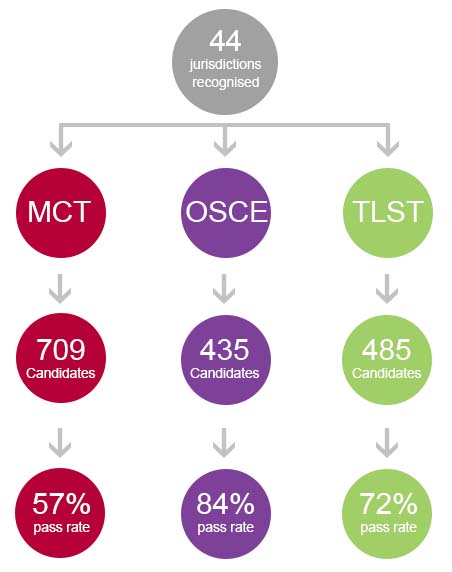
Figure 11
| Assessment | Number of candidates attempting whole assessment | Pass rates in percentages | ||||||
|---|---|---|---|---|---|---|---|---|
| Gender | Ethic group | First language | ||||||
| Female | Male | BME | White | Note stated | English | Other than English | ||
| MCT | 646 | 57.9% (356) | 54.8% (290) | 39.2% (268) | 67.3% (251) | 71.7% (127) | 61.0% (349) | 51.2% (297) |
| OSCE | 408 | 89.7% (224) | 76.6% (184) | 74.1% (116) | 87.4% (215) | 88.3% (77) | 86.3% (262) | 79.5% (146) |
| TLST | 545 | 73.3% (255) | 70.4% (199) | 59.3% (140) | 78.1% (233) | 76.5% (81) | 74.9% (291) | 41.4% (163) |
Equality and Diversity
- 20.
We know that BME1 students are well represented in the study of law at degree level: in 2012/13, 32% of all BME students in higher education were enrolled on law undergraduate programmes.2 This is reflected in the participation rate of students on the LPC. Research undertaken in higher education has identified a widening attainment gap between White and BME students across all provision and this is reflected in the completion rates for BME students on both the LPC and the CPE.3The variation in performance of students and QLTS candidates that may be associated with ethnicity (or any other protected characteristic) is of concern to us and is something that we want to better understand. The data collected for this report is a start to a better understanding and has enabled us to identify themes for future monitoring.
- 21.
We understand that the reasons for the variations in assessment performance between BME and White student are several and cumulative in their impact, and include gender, disability, type of education provider and social disadvantage. A lack of data around the profile of students securing training means that we have an incomplete picture of the progression from CPE and LPC to training. But even without this we know that successful progression along the solicitor qualification pathway does include a number of barriers to achieving a diverse profession. In 2010 the Legal Services Board published an evaluation of existing research in the area of diversity in the profession and concluded that what has emerged is a picture where "failing to get the right A-levels; not getting work experience in law firms while at school; attending the wrong university; training at the wrong firm all add up to insurmountable barriers that permanently effect the careers of lawyers and segregate the market."4 We are tackling these issues in our policy work on Training for Tomorrow.
- We use the term BME here to include all students who do not define themselves are White using the 2011 Census definitions.
- Higher Education Statistics Agency first statistical release 2012/13
- 'Differences in degree outcomes, Higher Education Funding Council, March 2014
- Rosaline Sullivan, Barriers to the legal profession, Legal Services Board 2010
